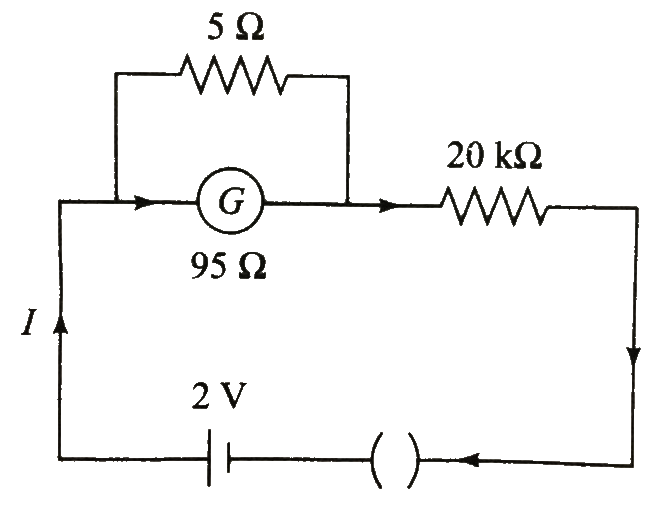A galvanometer of resistance 50Ω is connected to a battery of 3V along with resistance of 2950Ω in series. A full scale deflection of 30 divisions is obtained in the galvanometer. In order to reduce this deflection to 20 division the above series resistance should be
4450 Ω
5050 Ω
5550 Ω
6050 Ω
The correct Answer is:A
To solve the problem, we need to determine the new series resistance required to reduce the galvanometer deflection from 30 divisions to 20 divisions. Here’s a step-by-step solution:
Step 1: Understand the Initial Setup
We have a galvanometer with a resistance G=50Ω connected in series with a resistance R=2950Ω and a battery of voltage V=3V.
Step 2: Calculate the Current for Full Scale Deflection
The current I1 that produces full-scale deflection (30 divisions) can be calculated using Ohm's law:
I1=VR+G
Substituting the values:
I1=32950+50=33000=0.001A(or1mA)
Step 3: Set Up the Equation for Reduced Deflection
To achieve a deflection of 20 divisions, we denote the new series resistance as R′. The current I2 for this deflection can be expressed as:
I2=VR′+G
Since the deflection is proportional to the current, we can set up the ratio:
I2I1=2030=23
Step 4: Relate I2 and I1
From the above ratio, we can express I2:
I2=23I1=23×0.001=23000A
Step 5: Substitute I2 into the Current Equation
Now substituting I2 into the equation:
23000=3R′+50
Step 6: Cross-Multiply and Solve for R′
Cross-multiplying gives:
2(R′+50)=3×3000
2R′+100=9000
2R′=9000−100=8900
R′=89002=4450Ω
Step 7: Conclusion
The new series resistance R′ required to reduce the deflection to 20 divisions is 4450Ω.
We have a galvanometer with a resistance G=50Ω connected in series with a resistance R=2950Ω and a battery of voltage V=3V.
The current I1 that produces full-scale deflection (30 divisions) can be calculated using Ohm's law:
I1=VR+G
Substituting the values:
I1=32950+50=33000=0.001A(or1mA)
To achieve a deflection of 20 divisions, we denote the new series resistance as R′. The current I2 for this deflection can be expressed as:
I2=VR′+G
Since the deflection is proportional to the current, we can set up the ratio:
I2I1=2030=23
From the above ratio, we can express I2:
I2=23I1=23×0.001=23000A
Now substituting I2 into the equation:
23000=3R′+50
Cross-multiplying gives:
2(R′+50)=3×3000
2R′+100=9000
2R′=9000−100=8900
R′=89002=4450Ω
The new series resistance R′ required to reduce the deflection to 20 divisions is 4450Ω.
Topper's Solved these Questions
- CURRENT ELECTRICITYBOOK - DC PANDEY ENGLISHCHAPTER - CURRENT ELECTRICITYEXERCISE - B. Assertion and reason
18 Videos
- CURRENT ELECTRICITYBOOK - DC PANDEY ENGLISHCHAPTER - CURRENT ELECTRICITYEXERCISE - Match the columns
4 Videos
- CURRENT ELECTRICITYBOOK - DC PANDEY ENGLISHCHAPTER - CURRENT ELECTRICITYEXERCISE - Check point
70 Videos
- COMMUNICATION SYSTEMBOOK - DC PANDEY ENGLISHCHAPTER - COMMUNICATION SYSTEMEXERCISE - Subjective
11 Videos
- ELECTROMAGNETIC INDUCTIONBOOK - DC PANDEY ENGLISHCHAPTER - ELECTROMAGNETIC INDUCTIONEXERCISE - Medical entrances gallery
25 Videos
Similar Questions
A galvanometer of resistance 50Ω is connected to a battery of 3V along with a resistance of 2950Ω in series. A full scale deflection of 30 division is obtained in the galvanometer. In order to reduce this deflection to 20 division, the resistance in series should be:-
View SolutionA galvanometer of resistance 50Ω is connected to a battery of 8 V along with a resistance of 3950Ω in series. A full scale deflection of 30 divisions is obtained in the galvanometer. In order to reduce this deflection to 15 divisions, the resistance in series should be .... Ω.
View Solution
Knowledge Check
A galvanometer of resistance 25Ω is connected to a battery of 2 volt along with a resistance in series. When the value of this resistance is 3000Ω, a full scale deflection of 30 units is obtained in the galvanometer. In order to reduce this deflection to 20 units, the resistance in series will be
A4512ΩB5413ΩC2000ΩD6000Ω
A galvanometer of resistance 30Ω is connected to a battery of emf 2 V with 1970Ω resistance in series. A full scale deflection of 20 divisions is obtained in the galvanometer. To reduce the deflection to 10 divisions, the resistance in series required is
View SolutionA galvanometer of 50Ω resistance when connected across the terminals of a battery of emf 2V along with the resistance 200Ω the deflection produced in the galvanometer is 10 divisions. If the total number of divisions on the galvanometer ·scale on either side of central zero is 30, then the maximum current that can pass through the galvanometer is
View SolutionA galvanometer having internal resistance 10Ω required 0.01 A for a full scale deflection. To convert this galvanometer to a voltmeter of full scale deflection at 120 V, we need to connect a resistance of
View SolutionTo measure the resistance of a galvanometer by half deflection method, a shunt is connected to the galvanometer . The shunt is
View SolutionA galvanometer of resistance 50Ω is converted into an ammeter by connecting a low resistance (shunt) of value 1Ω in parallel to the galvanometer, S. If full - scale deflection current of the galvanometer is 10 mA, then the maximum current that can be measured by the ammeter is -
View SolutionA galvanometer has resistance 1Ω. Maximum deflection current through it is 0.1 A
View SolutionA galvanometer of resistance 95Ω, shunted resistance of 5Ω, gives a deflection of 50 divisions when joined in series with a resistance of 20kΩ and a 2V accumulator. What is the current sensitivity of the galvanomter (in div/μA)?

View Solution
